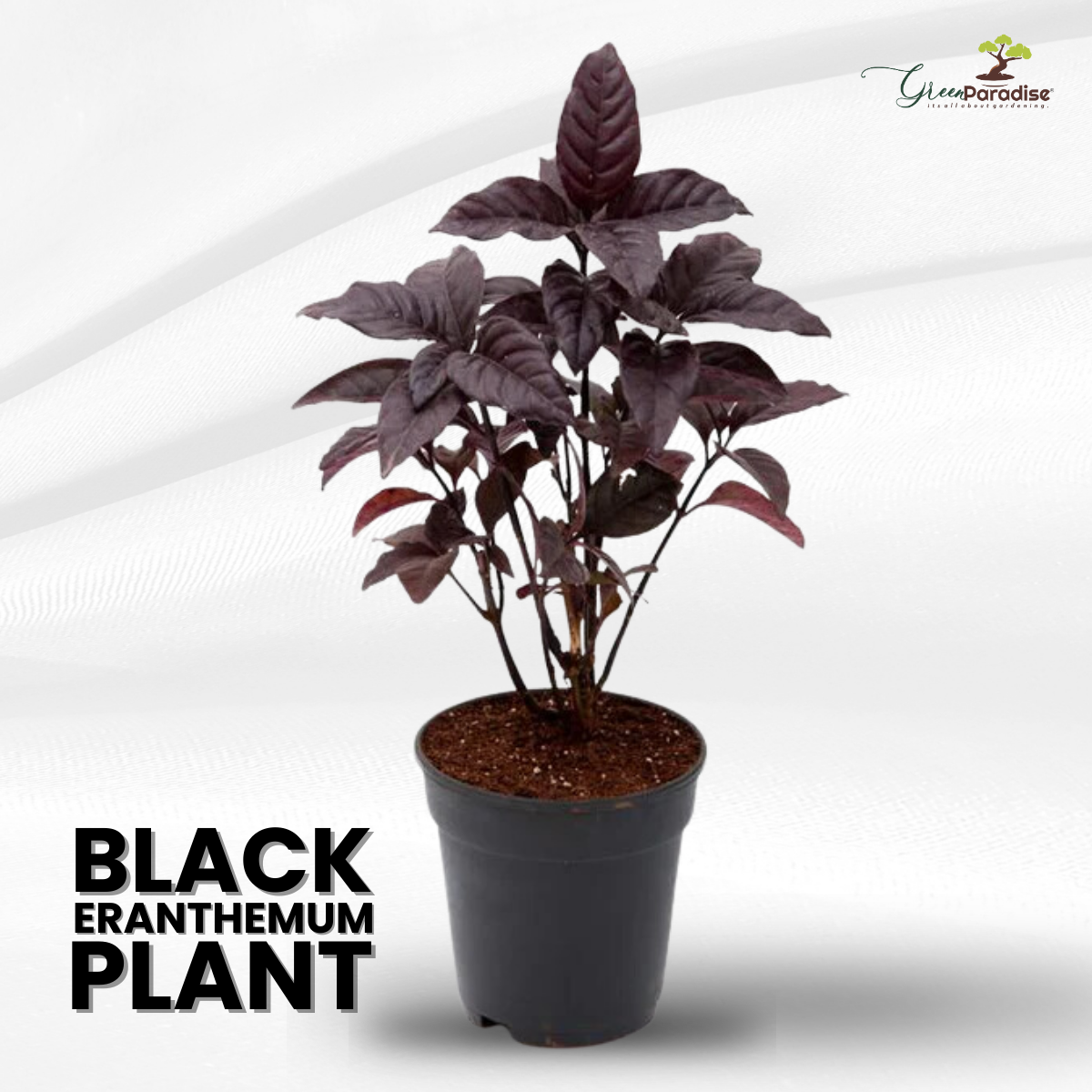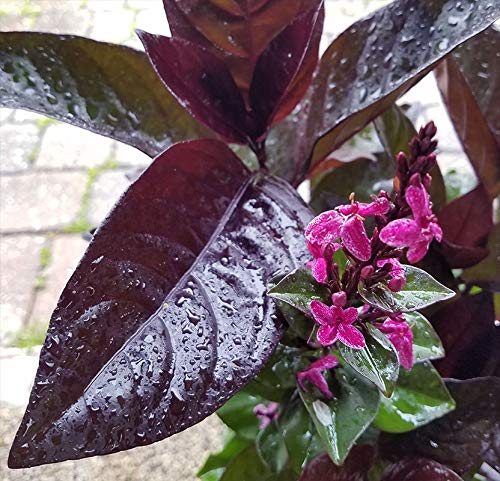



Green Paradise Offers Beautiful Black
Earanthamum Plant
About Black Earanthamum Plant
The flowering plant species Black Eranthemum referred to as Black Pagoda Plant, belongs to the family Acanthaceae. It is native to Southeast Asia, particularly in Thailand, Myanmar, and Malaysia. Eranthemum nigrum is known for its striking dark foliage, which sets it apart from many other plants.
Here are some key characteristics of Black Eranthemum:
Appearance:
-
The Black Eranthemum is a medium-sized evergreen shrub that can reach a height of about 1 to 2 meters (3 to 6 feet).
-
It has glossy, leathery leaves that are deep green to almost black in color, which gives the plant its name.
-
The leaves are oblong or elliptical in shape and have prominent veins.
Flowers:
-
The plant produces small, tubular flowers that are typically blue or purple.
-
These flowers are arranged in dense clusters on upright spikes that emerge from the leaf axils.
-
The blooming period usually occurs during the warmer months.
Growing conditions:
-
Black Eranthemum thrives in tropical and subtropical regions.
-
It prefers well-draining soil and a partially shaded location.
-
Although it can tolerate full sun, it is generally recommended to provide some shade to prevent leaf scorching.
-
This plant is suitable for outdoor cultivation in USDA hardiness zones 10 to 12, but it can also be grown as a houseplant.
Care:
-
To care for Black Eranthemum it is important to provide regular watering to keep the soil moist but not waterlogged.
-
Fertilizing every month or two with a balanced fertilizer can promote healthy growth.
-
Pruning can be done to maintain its shape and encourage bushier growth.
-
In colder regions, it is advisable to bring the plant indoors during winter or provide protection from frost.
Uses:
-
Black Eranthemum is primarily grown for its ornamental value.
-
Its dark foliage adds a unique touch to gardens and landscapes, providing a striking contrast when planted alongside lighter-colored plants.
-
It can be used as a specimen plant, in mixed borders, or as a container plant for patios or indoor spaces.
It's worth noting that while Black Eranthemum nigrum is an attractive and interesting plant, it may not be as widely available in nurseries or garden centers compared to more common houseplants or garden favorites. If you're interested in growing this plant.
How To Grow Black Earanthamum Plant
Here are some general guidelines to help you grow and care for Black Eranthemum:
Light:
- Place your Black Eranthemum plant in a location with bright, indirect light.
- It thrives in partial shade or filtered sun.
- Avoid placing it in direct sun, as it can scorch the leaves.
Temperature:
- Black Eranthemum prefers warm temperatures between 65°F to 85°F (18°C to 29°C).
- Protect it from cold drafts or sudden temperature changes, as they can cause leaf drop or growth problems.
Watering
- Maintain a constant but not excessive moisture in the soil.
- When the top inch of soil feels dry, water the factory. It is important to maintain adequate humidity levels, especially in drier environments, to prevent the foliage from drying out.
- You can achieve this by misting the leaves or placing a tray with water near the plant.
Soil:
- Use a well-draining replanting blend that retains some humidity but does not come doused.
- An admixture of peat moss, perlite, and regular replanting soil can work well
Fertilization:
- Feed your Black Eranthemum plant with a balanced, water-soluble fertilizer during the growing season (spring and summer).
- Follow the instructions on the toxin package for the correct lozenge and frequency.
- Reduce or halt fertilization during the downtime months
Pruning:
- Prune your Black Eranthemum plant to maintain its shape and remove any dead or damaged leaves.
- You can also pinch back the tips to encourage bushier growth.
Propagation:
- Black Eranthemum can be propagated through stem tip cuttings.
- Take a 4-6 inch (10-15 cm) cutting from a healthy stem, remove the lower leaves, and place it in a moist potting mix.
- give warmth and moisture to encourage root development.
- Once roots have formed, you can plant the slice into a larger pot.
Pests and conditions:
- Keep an eye out for common houseplant pests like aphids, mealybugs, and spider diminutive.
- Use a suitable insecticidal soap or neem oil to eradicate any infestations you find. Avoid overwatering to prevent root rot.
Remember that Black Eranthemum is a tropical plant, so it requires a warm and humid environment to thrive. By providing the right conditions of light, temperature, water, and care, you can enjoy the beautiful foliage and delicate flowers of this plant.




